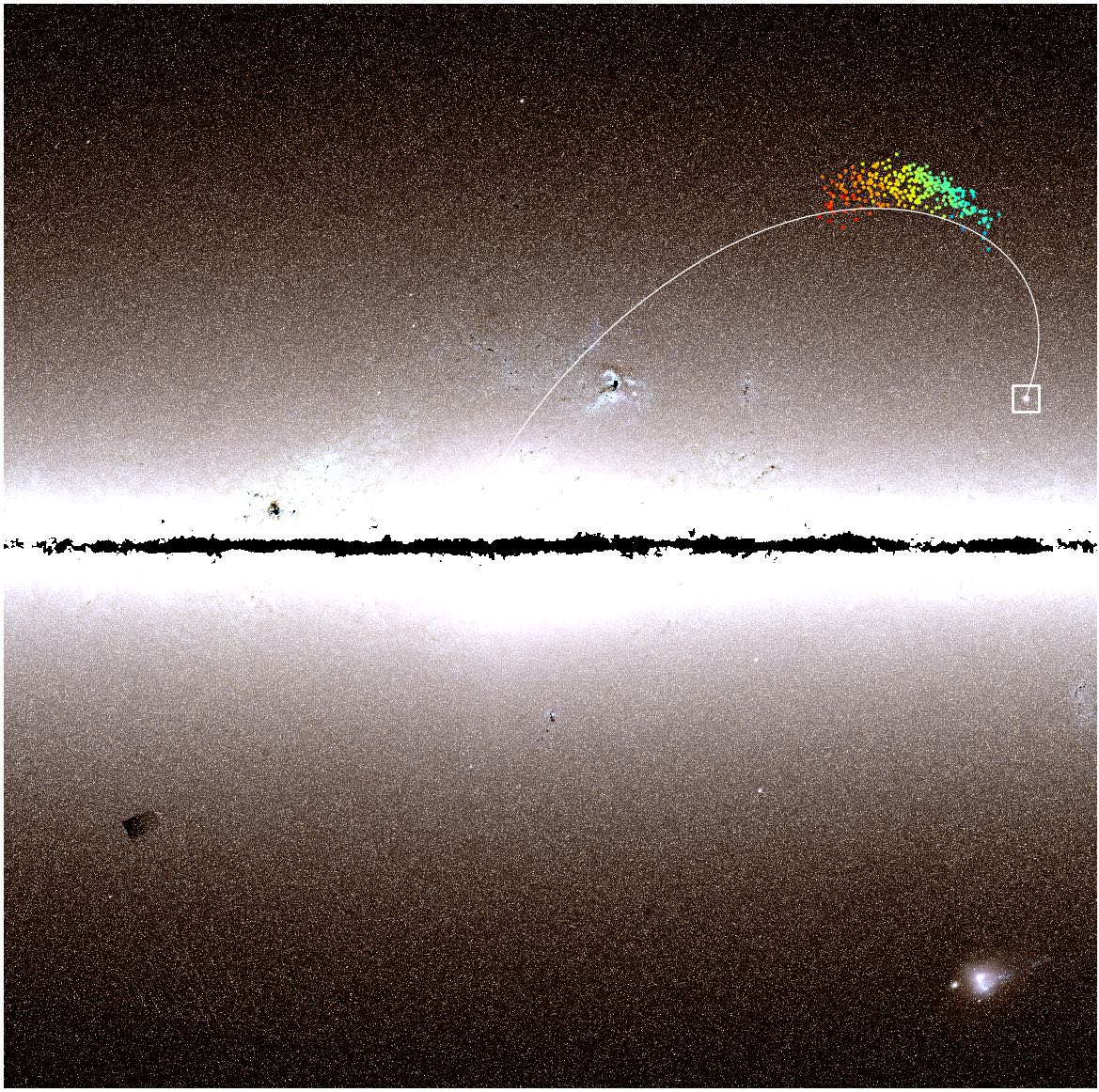IoW_20190422 - Gaia
Image of the Week |
omega Centauri's lost stars |
|
|
|
A wide view towards the center of the Milky Way, as seen by Gaia. The "Fimbulthul" stream of co-moving stars are shown coloured according to their motions as measured by Gaia. This study reports that these stars have been lost from the omega Centauri globular cluster (white box) as the latter slowly dissolves along its orbit (white line) through the Milky Way. Image credit: Rodrigo A. Ibata, Michele Bellazzini, Khyati Malhan, Nicolas Martin and Paolo Bianchini. |
|
A team of researchers from the Strasbourg Astronomical Observatory, Bologna Observatory and the University of Stockholm has identified a stream of stars that was torn off the globular cluster ω Centauri. Searching through the 1.7 billion stars observed by the ESA Gaia mission, they have identified 309 stars that suggest that this globular cluster may actually be the remnant of a dwarf galaxy that is being torn apart by the gravitational forces of our Galaxy. In 1677, Edmond Halley gave the name “omega Centauri” (ω Cen) to what he thought was a star in the Centaurus constellation. Later in 1830 John Herschel realized that it was in fact a globular cluster that could be resolved into individual stars. We now know that ω Centauri is the most massive globular cluster in the Milky Way: it is about 18,000 light years from us and contains several million stars that are about 12 billion years old. The nature of this object has been the subject of much debate: is it really a globular cluster, or could it be the heart of a dwarf galaxy whose periphery has been dispersed by the Milky Way? This last hypothesis is based on the fact that ω Cen contains several stellar populations, with a large range of metallicities (i.e. heavy element content) that betray a formation over an extended period of time. An additional argument in favour of this hypothesis would be to find debris from the cluster scattered along its orbit in the Milky Way. Indeed, when a dwarf galaxy interacts with a massive galaxy like our own, stars are torn off by gravitational tidal forces, and these stars remain visible for a time as stellar streams, before becoming dispersed in the vast volumes of interstellar space surrounding the massive galaxy. Gaia has measured the motions of the stars on the celestial sphere with such a high precision, that researchers identified several star streams. This identification was performed with the use of an algorithm called STREAMFINDER. One of them, named “Fimbulthul” (after one of the rivers in Norse mythology that existed at the beginning of the world), contains 309 stars stretching over 18° in the sky. By modeling the trajectories of the stars, the team showed that the Fimbulthul structure is a stellar tidal stream torn off ω Cen, extending up to 28° from the cluster. Spectroscopic observations of five stars of this stream with the Canada-France Hawaii Telescope show that their velocities are very similar, and that they have metallicities comparable to the stars of ω Cen itself, which reinforces the idea that the tidal stream is linked to ω Cen. The researchers were then able to show that the stream is also present in the very crowded area of sky in the immediate vicinity of the cluster. Further modeling of the tidal stream will constrain the dynamical history of the dwarf galaxy that was the progenitor of ω Cen, and could help to find even more stars lost by this system into the halo of the Milky Way. The story was based on the paper "Identification of the Long Stellar Stream of the Prototypical Massive Globular Cluster omega Centauri" appearing today in Nature Astronomy. The work in this paper is also based upon the following article: "The Streams of the Gaping Abyss: A Population of Entangled Stellar Streams Surrounding the Inner Galaxy". |
|
Credits: Rodrigo Ibata, Michele Bellazzini, Khyati Malhan, Nicolas Martin, Paolo Bianchini [Published: 22/04/2019] |
- Removed a total of (4) style text-align:center;
- Removed a total of (4) style text-align:justify;
- Removed a total of (1) border attribute.
- Removed a total of (1) cellpadding attribute.
- Removed a total of (1) cellspacing attribute.
Image of the Week Archive
- Removed a total of (1) border attribute.
- Removed a total of (1) cellpadding attribute.
- Removed a total of (1) cellspacing attribute.








































 Sign in
Sign in
 Science & Technology
Science & Technology
